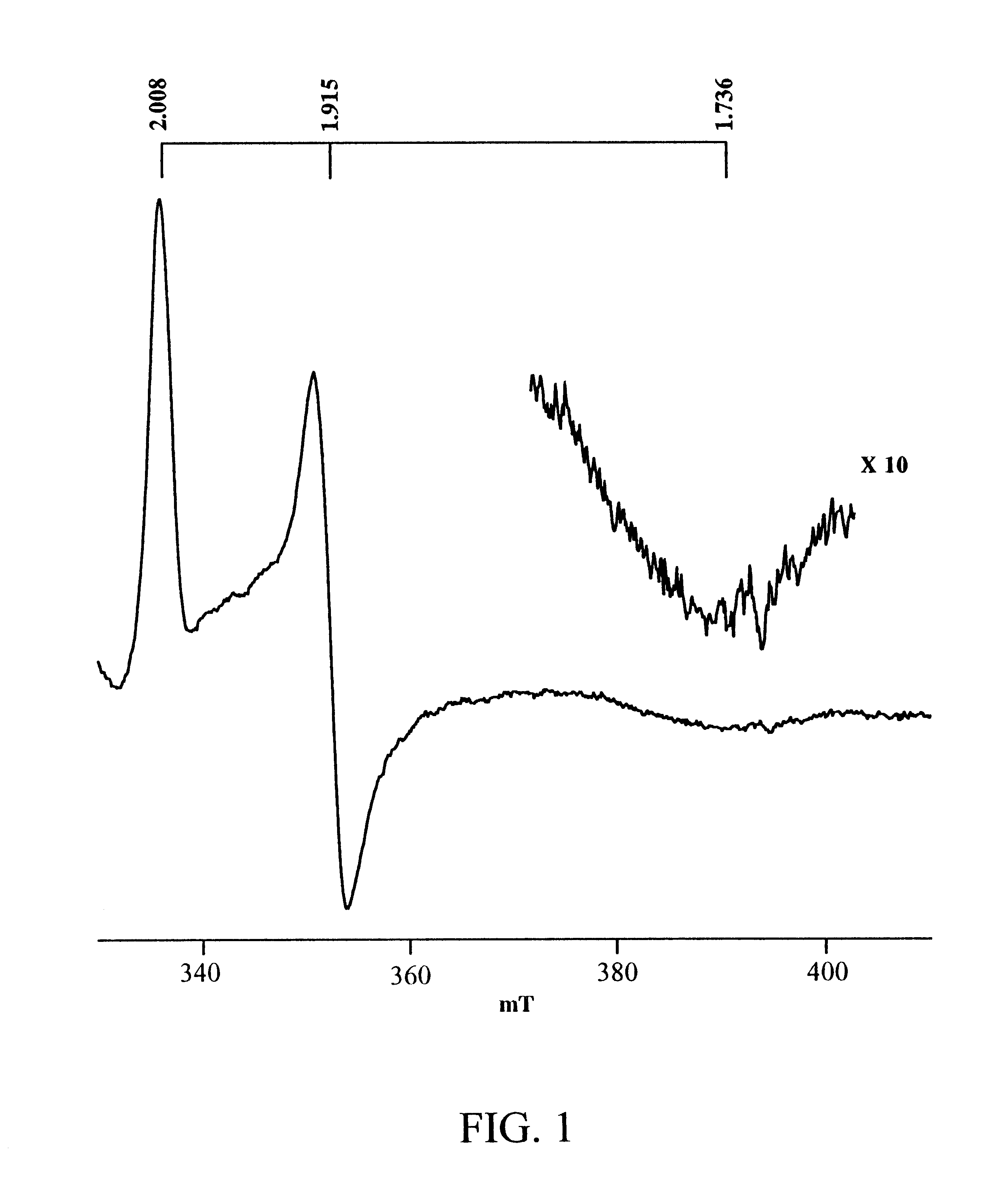Polynucleotides encoding choline monooxygenase and plants transformed therewith
a technology of choline monooxygenase and polynucleotides, which is applied in the field of polynucleotides encoding choline monooxygenase and plants transformed therewith, can solve the problems of crop production impossible, rapid dwindling of available crop producing farm land, and only going to worsen
- Summary
- Abstract
- Description
- Claims
- Application Information
AI Technical Summary
Problems solved by technology
Method used
Image
Examples
example 2
EPR Spectroscopy
Samples of purified CMO were adjusted to pH 10 with Glycine-KOH and reduced by adding 1 mg Na dithionite per 300 .mu.L. They were analyzed using a Bruker ECS 106 EPR X-band spectrometer with ER 4116 DM resonator and an Oxford liquid helium cryostat. Temperature was controlled by an Oxford Intelligent controller, and monitored with a thermocouple 3 mm beneath the sample tube with liquid nitrogen as the reference. The microwave frequency was sampled by a Hewlett-Packard 5340A frequency counter. Data manipulations were carried out using the program IgorPro 2.04 (Wavemetrics, Lake Oswego, Oreg.).
example 3
Peptide Microsequencing
Purified CMO was subjected to SDS-PAGE and the M.sub.r.apprxeq.45,000 band was blotted to polyvinylidene difluoride membrane. Tryptic peptides were generated by the procedure of Fernandez et al. (1994) and purified by reverse-phase HPLC using an Aquapore RP-300(C-8, 2.1.times.220 mm) column developed with a trifluoroacetic acid-acetonitrile gradient. Isolated peptides were subjected to sequence analysis on an ABI Model 476A protein / peptide sequencer (Perkin-Elmer ABD). The N-terminal sequence of the intact protein was determined on a sample further purified by reverse-phase HPLC.
example 4
Total RNA from salinized spinach leaves was extracted as described (Hall et al., 1978), except that a step to precipitate carbohydrates with 75 mM BaCl.sub.2 was added. Poly (A).sup.+ RNA was isolated using Poly (U) Sephadex (Hondred et al., 1987), and used to construct a cDNA library (9.times.10.sup.6 pfu) in .lambda. UniZap XR (Stratagene). A 532-bp DNA fragment was generated by reverse transcription (RT)-PCR with primers based on CMO peptides; the (+) and (-) primers were respectively 5'-CCIGA(A / G)CA(A / G)AA(T / C)(T / C)TNGA(C / T)CCIAA(A / G)G-3' (SEQ ID NO: 5) and 5'-CCATCAT(A / G)TT(C / T)TC(C / T)TC(T / G / A)AT(A / G)TA(A / G)TA(A / G)TC-3' (SEQ ID NO: 6). The RT-PCR reaction (100 .mu.L) contained 3 ng first-strand cDNA, 40 pmol of each primer, 200 .mu.M each of all four dNTPs, 50 mM KCl, 1.5 mM MgCl.sub.2, 0.001 % (w / v) gelatin and 2.5 units of AmpliTaq DNA polymerase(Perkin-Elmer)in 10 mM Tris-HCl,pH 8.3. Forty cycles of 0.5 min each at 94.degree. C. and 30.degree. C. and 1 min at 50....
PUM
| Property | Measurement | Unit |
|---|---|---|
| pH | aaaaa | aaaaa |
| resistance | aaaaa | aaaaa |
| salinity | aaaaa | aaaaa |
Abstract
Description
Claims
Application Information
 Login to View More
Login to View More - R&D
- Intellectual Property
- Life Sciences
- Materials
- Tech Scout
- Unparalleled Data Quality
- Higher Quality Content
- 60% Fewer Hallucinations
Browse by: Latest US Patents, China's latest patents, Technical Efficacy Thesaurus, Application Domain, Technology Topic, Popular Technical Reports.
© 2025 PatSnap. All rights reserved.Legal|Privacy policy|Modern Slavery Act Transparency Statement|Sitemap|About US| Contact US: help@patsnap.com


